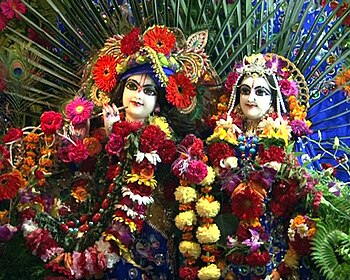Thumrī is a common genre of semi-classical Indian music.
The text is romantic or devotional in nature, and usually revolves around a girl's love for Lord Krishna . The lyrics are usually in Uttar Pradesh dialects of Hindi called Awadhi and Brij Bhasha. Thumri is characterized by its sensuality, and by a greater flexibility with the raga.
Some of the most commonly used ragas are Pilu, Kafi, Khamaj, Gara, Tilak Kamod and Bhairavi. The compositions are usually set to kaherava taal of 8 beats, addha talof 16 beats, dipchandi of 14 beats or jat of 16 beats and in "dadra' tal of 6 beats.
Some of the most commonly used ragas are Pilu, Kafi, Khamaj, Gara, Tilak Kamod and Bhairavi. The compositions are usually set to kaherava taal of 8 beats, addha talof 16 beats, dipchandi of 14 beats or jat of 16 beats and in "dadra' tal of 6 beats.
Thumrī is also used as a generic name for some other, even lighter, forms such as Dadra
| People worshiping lord Krishna in During Janmasthami. (Photo credit: Wikipedia) |
Thumrī arose in popularity during the 19th century in the Lucknow court of nawab Wajid Ali Shah. At that time it used to be a song sung by courtesans accompanied by dance. That was the bandish ki thumri or bol bant ki thumri. When this style of thumrī went out of vogue at the turn of the 20th century, a new style became more popular, which is known as bol banao, sung in Varanasi. Since Varanasi is to the east (poorab) of Lucknow, the new style became known as Poorab ang or eastern style thumrī
Hori, Kajari, Saavan, Jhoola, and Chaiti, even though each of them has its own structure and content — either lyrical or musical or both — and so the exposition of these forms vary. Like Indian classical music itself, some of these forms have their origin in folk literature and music.
Some of the noted vocalist of Thumri style of classical music are Pt Bhimsen Joshi. Prabha Atre and Shobha Gurtu.
---daman
25/02/2014
Some of the noted vocalist of Thumri style of classical music are Pt Bhimsen Joshi. Prabha Atre and Shobha Gurtu.
---daman
25/02/2014





No comments:
Post a Comment